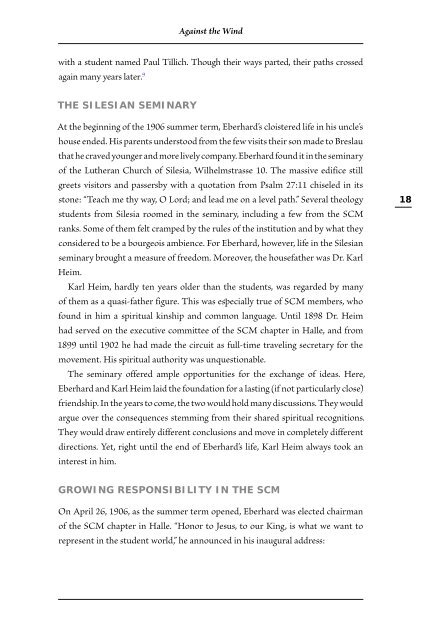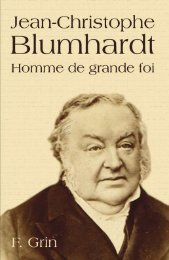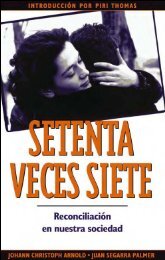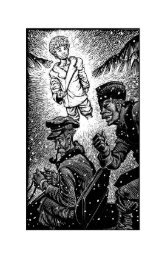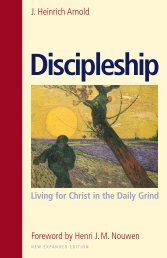Against the Wind: Eberhard Arnold and the Bruderhof - Plough
Against the Wind: Eberhard Arnold and the Bruderhof - Plough
Against the Wind: Eberhard Arnold and the Bruderhof - Plough
Create successful ePaper yourself
Turn your PDF publications into a flip-book with our unique Google optimized e-Paper software.
<strong>Against</strong> <strong>the</strong> <strong>Wind</strong><br />
with a student named Paul Tillich. Though <strong>the</strong>ir ways parted, <strong>the</strong>ir paths crossed<br />
again many years later. 9<br />
thE SilESian SEminary<br />
At <strong>the</strong> beginning of <strong>the</strong> 1906 summer term, <strong>Eberhard</strong>’s cloistered life in his uncle’s<br />
house ended. His parents understood from <strong>the</strong> few visits <strong>the</strong>ir son made to Breslau<br />
that he craved younger <strong>and</strong> more lively company. <strong>Eberhard</strong> found it in <strong>the</strong> seminary<br />
of <strong>the</strong> Lu<strong>the</strong>ran Church of Silesia, Wilhelmstrasse 10. The massive edifice still<br />
greets visitors <strong>and</strong> passersby with a quotation from Psalm 27:11 chiseled in its<br />
stone: “Teach me thy way, O Lord; <strong>and</strong> lead me on a level path.” Several <strong>the</strong>ology<br />
students from Silesia roomed in <strong>the</strong> seminary, including a few from <strong>the</strong> SCM<br />
ranks. Some of <strong>the</strong>m felt cramped by <strong>the</strong> rules of <strong>the</strong> institution <strong>and</strong> by what <strong>the</strong>y<br />
considered to be a bourgeois ambience. For <strong>Eberhard</strong>, however, life in <strong>the</strong> Silesian<br />
seminary brought a measure of freedom. Moreover, <strong>the</strong> housefa<strong>the</strong>r was Dr. Karl<br />
Heim.<br />
Karl Heim, hardly ten years older than <strong>the</strong> students, was regarded by many<br />
of <strong>the</strong>m as a quasi-fa<strong>the</strong>r figure. This was esecially true of SCM members, who<br />
found in him a spiritual kinship <strong>and</strong> common language. Until 1898 Dr. Heim<br />
had served on <strong>the</strong> executive committee of <strong>the</strong> SCM chapter in Halle, <strong>and</strong> from<br />
1899 until 1902 he had made <strong>the</strong> circuit as full-time traveling secretary for <strong>the</strong><br />
movement. His spiritual authority was unquestionable.<br />
The seminary offered ample opportunities for <strong>the</strong> exchange of ideas. Here,<br />
<strong>Eberhard</strong> <strong>and</strong> Karl Heim laid <strong>the</strong> foundation for a lasting (if not particularly close)<br />
friendship. In <strong>the</strong> years to come, <strong>the</strong> two would hold many discussions. They would<br />
argue over <strong>the</strong> consequences stemming from <strong>the</strong>ir shared spiritual recognitions.<br />
They would draw entirely different conclusions <strong>and</strong> move in completely different<br />
directions. Yet, right until <strong>the</strong> end of <strong>Eberhard</strong>’s life, Karl Heim always took an<br />
interest in him.<br />
growing rESponSibility in thE SCm<br />
On April 26, 1906, as <strong>the</strong> summer term opened, <strong>Eberhard</strong> was elected chairman<br />
of <strong>the</strong> SCM chapter in Halle. “Honor to Jesus, to our King, is what we want to<br />
represent in <strong>the</strong> student world,” he announced in his inaugural address:<br />
18


